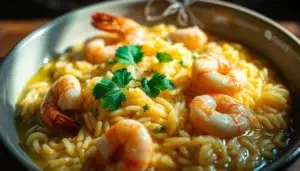Imagine sitting around the table with your family, the smell of a great meal in the air. A tasty homemade side dish is often the highlight of these moments. It makes the meal even better.

So, what makes this dish so special? It’s its flexibility and how it brings everyone together. As you learn to make the perfect seafood dressing recipe, you’ll find ways to make your meals unforgettable.
Key Takeaways
- Learn the basics of creating a delicious homemade seafood accompaniment.
- Discover the key ingredients that make this dish special.
- Understand the importance of this recipe in making your holiday gatherings better.
- Explore tips for customizing the recipe to suit your taste.
- Get insights into making your meals more memorable with this versatile dish.
The Art of Seafood Dressing
Seafood dressing is a mix of flavors and textures that makes any meal special. It combines fresh seafood with traditional ingredients. This creates a dish that’s both comforting and elegant.
What Makes Seafood Dressing Special
Seafood dressing is special because of its unique mix of seafood components and traditional ingredients. Fresh seafood like shrimp, crab, or oysters add depth and flavor. This makes a traditional seafood dressing recipe a favorite among many.
Regional Variations Across America
In America, seafood dressing is made differently in each region. In the South, it might use cornbread as a base. Near the coast, it often includes fresh seafood. This variety keeps seafood dressing exciting and diverse.
Occasions Perfect for Seafood Dressing
Seafood dressing is great for many occasions, from casual get-togethers to formal holidays. It’s easy to make ahead and can be served in various ways. Whether you want to impress guests or enjoy a cozy meal, seafood dressing is perfect.
Essential Ingredients for the Perfect Seafood Dressing Recipe
A great seafood dressing recipe starts with fresh, flavorful ingredients. To make a dish that stands out, you need to know the key parts.

Seafood Components: Selecting the Best Options
The seafood is the main attraction. Picking the right types is key. You can choose from shellfish to finfish, each bringing its own taste and texture.
Shellfish Choices
Shrimp, crab, and oysters are top picks for seafood dressing. They bring a deep, salty taste and a nice texture. Make sure they’re fresh and cooked right to stay safe.
Finfish Alternatives
For finfish lovers, cod, haddock, or salmon are great options. Finfish offer a milder taste, perfect for those who prefer a lighter flavor.
Base Ingredients: Bread, Vegetables, and Herbs
The base of your dressing is just as important. Bread is the base, while vegetables like onions, celery, and bell peppers add flavor. Fresh herbs like parsley, thyme, or sage add a nice aroma.
Try using cornbread for a “seafood dressing recipes cornbread” twist. It adds a sweet taste and a crunchy texture.
Binding Agents and Seasonings
Binding agents like eggs and butter or oil keep your dressing together. They also add flavor. Choose seasonings like salt, pepper, and spices to make it even better. This makes your dressing not only tasty but also easy to make.
By focusing on these key ingredients and making healthy choices, you can make a healthy seafood dressing that’s both tasty and good for you.
Step-by-Step Seafood Dressing Recipe
Making a tasty seafood dressing is a fun process. It involves several steps to make sure it’s delicious. Follow these steps to create a delicious seafood dressing that everyone will love.
Preparing Your Seafood
The first step is to prepare your seafood. Clean and devein it, then cook it until it’s tender.
Cleaning and Deveining Techniques
Start by rinsing your seafood under cold water and patting it dry. To devein shrimp, make a shallow cut along the back. Then, gently pull out the vein.
Pre-cooking Methods
You can pre-cook seafood by steaming, boiling, or sautéing. Steaming keeps flavors delicate. Boiling is quick but needs careful timing. Sautéing adds a nice color and flavor. Pick a method that fits your seafood and flavor preferences.

Creating the Base Mixture
The base of your dressing is important. It includes stale bread, onions, celery, and herbs. Tear the bread into small pieces and sauté the vegetables until they’re soft. Mix these together to start your dressing.
Combining and Seasoning
Now, mix your seafood with the base mixture. Fold the seafood into the base gently, making sure everything is coated.
Texture Adjustments
To get the right texture, you might need to add moisture. If it’s too dry, use broth or melted butter. If it’s too wet, add more bread to soak up the moisture.
Flavor Balancing
Seasoning is key for a quick seafood dressing with great flavor. Taste as you go and adjust the seasoning. Use herbs, spices, salt, and pepper to balance the flavors.
By following these steps, you can make a delicious seafood dressing for any event. This guide helps you make a traditional or new recipe.
Here are some key takeaways to remember:
- Prepare your seafood with care, using appropriate cleaning and pre-cooking methods.
- Create a solid base with bread, vegetables, and herbs.
- Combine your seafood and base mixture gently.
- Adjust the texture and flavor to your liking.
Cooking Methods and Serving Suggestions
Now that you’ve made your seafood dressing, it’s time to cook it. The cooking method you pick can really change how it tastes. It’s key to know your options.
Oven-Baked Seafood Dressing
Baking your dressing in the oven is a favorite. It heats evenly and can make the top crispy. Preheat to 350°F (175°C) and bake for 25-30 minutes. It should be golden brown on top and warm inside.
Stovetop Variations
Cooking on the stovetop is also good. It’s great if you don’t have oven space or like a different texture. Just heat it in a skillet over medium, stirring often, until it’s warm and slightly browned.
Make-Ahead and Storage Tips
Seafood dressing is great because you can make it ahead. You can prep it a day before and refrigerate it. Then, bake or heat it when you’re ready. For longer storage, freeze it tightly.
Perfect Pairings and Garnishes
Think about what goes well with your dressing. The right pairings can make your meal better.
Complementary Main Dishes
Seafood dressing is good with roasted meats like turkey or chicken. It also pairs well with grilled fish or veggies. Pick a main dish that matches your dressing’s flavors.
Wine and Beverage Pairings
A dry white wine, like Chardonnay or Sauvignon Blanc, is a great match. For those who don’t drink wine, a crisp lager or citrus water can refresh your palate.
Conclusion
Now you know how to make seafood dressing, perfect for your next event or holiday meal. You’ve learned to pick the best seafood, make a base, and mix it all together. This makes a delicious homemade seafood dressing.
Don’t be afraid to try new things with your seafood dressing. You can bake it in the oven or cook it on the stovetop. Your homemade seafood dressing will be a big hit. So, have fun and make it your own.
With these easy steps, you’re ready to make a seafood dressing that everyone will love. It’s going to be a hit at your next gathering.
FAQ
What is seafood dressing, and how does it differ from seafood stuffing?
Can I use cornbread for my seafood dressing recipe?
What are some common seafood options used in seafood dressing?
How do I store leftover seafood dressing?
Can I make seafood dressing ahead of time?
What are some healthy alternatives for seafood dressing?
How do I achieve the perfect texture for my seafood dressing?
Can I use different types of bread for seafood dressing?
There are no reviews yet. Be the first one to write one.



